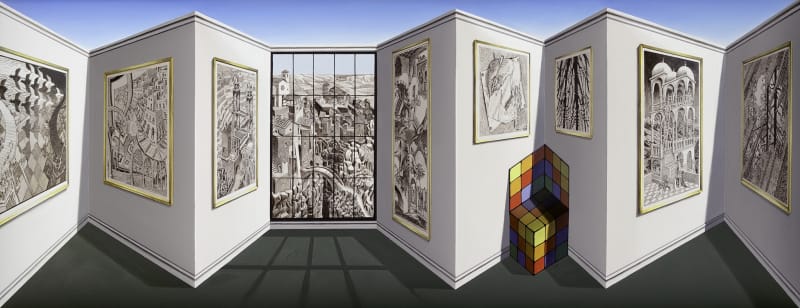Overview
Fifty years after the exhibition of his first reverse perspective painting, the Sticking-out Room, and on the occasion of the artist's 75th birthday, Flowers Gallery is delighted to announce an exhibition of compelling new works by Patrick Hughes, which expand on his lifelong theme of paradoxical perception.
"My pictures seem to move as you move. They come to life when we bring them to life. This is because they are made in perspective the wrong way round, in reverspective. If you bob down in front of them, it is as if you have gone up, and as you walk past to the right it is as if you have gone to the left and vice versa."- Patrick Hughes.
Fifty years after the exhibition of his first reverse perspective painting, the Sticking-out Room, and on the occasion of the artist's 75th birthday, Flowers Gallery is delighted to announce an exhibition of compelling new works by Patrick Hughes, which expand on his lifelong theme of paradoxical perception.
Since his breakthrough discovery of reverse perspective, Hughes has continued to confound viewers with his three-dimensional paintings, by presenting those parts of the picture that seem farthest away at the nearest point. The visual effect of his works is one of constant motion, determined by the shifting position of the viewer. As Professor Dawn Ades describes in the opening essay for the Patrick Hughes book, A New Perspective: "These really have to be experienced physically, in the flesh, for they are only activated fully by the spectator's movement. They thus take their place, with Duchamp's Large Glass and Etant donn̩s, Dal's paranoiac-critical room (Mae West's Face Which May Be Used as a Surrealist Apartment), or the now-vanished surrealist installations, as creations that need the physical presence of a spectator to be complete, engaging the body as well as the eye and the mind."
The new series of works on view at Flowers Gallery are in the artist's own words "as unusual as usual". Spanning a wide range of subjects, Hughes pays homage to a hero in The Pleasure of Escher; reimagines Peggy Guggenheim's Museum in Venice in The Palace of Peggy; and even anthologizes his own work in Hughestory, in which the artist represents ten three-dimensional works from his past.
Hughes' enduring fascination with Venice continues with Eye Level, presenting a new view of the city's waterways; In Black and White, painted in exquisite chiaroscuro; and Venice in Peril in which, displaying a rare critique of modern life, Hughes paints a towering cruise ship dwarfing the grand palazzos.
Hughes brings a Renaissance studiolo to life in A Study of the Studiolo, re-presenting in post-modern terms the first important steps in the re-birth of pictorial space that we now take for granted in photography and film. Murray McDonald described Hughes' reverspectives as"the first breakthrough in perspective for over five hundred years," after Brunelleschi's invention of perspective in 1420.
Hughes continues to explore and refine new geometries upon which to paint. The deceptively simple composition of Setting the Stage is, on closer inspection, composed of a complex variety of interlocking, protruding shapes, including a stage set in forced perspective; while further experimentation is evident in Hughestory, in which miniature reverspectives placed at the ends of its corridors pose an additional challenge to the spectator's perception of perspectival space.
Of Hughes' paintings, Colin Blakemore, Professor of Neuroscience, University of Oxford, says: "I shall never forget the first time I saw one of Patrick Hughes' large Reverspective paintings It almost literally knocked me over. I've spent much of my working life thinking about the way in which the brain puts together different sources of evidence about the 3-D world. But while I think, Patrick explores. He has unashamedly trekked through the no-man's-land between Art and Science, demonstrating the brain's remarkable powers not with brain scanners and fancy equipment, but with stunning images that are personal in a very special way - responding to the command of every viewer. His work can be judged, and enjoyed, at so many levels. It raises questions just as profound about the mechanisms in our brains as it does about the nature of an artistic representation."
Fifty years after the exhibition of his first reverse perspective painting, the Sticking-out Room, and on the occasion of the artist's 75th birthday, Flowers Gallery is delighted to announce an exhibition of compelling new works by Patrick Hughes, which expand on his lifelong theme of paradoxical perception.



